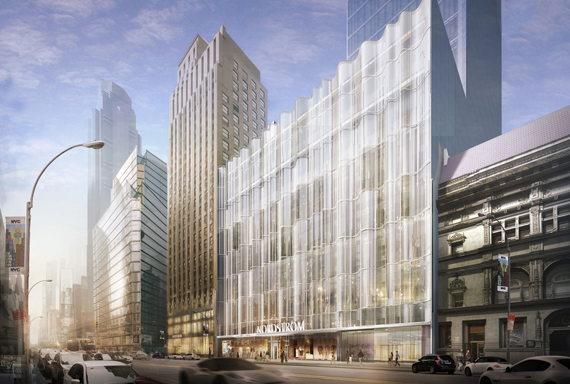These are not happy times for department stores. The rise of online merchants and discount chains, along with the shift in consumers’ buying habits, have cut into their sales and forced the closure of hundreds of branches. Over the past 12 months, Macy’s stock has plummeted by more than 52 percent. Yet it is under this very dark cloud that the renowned luxury retailer Nordstrom recently unveiled its plans for the company’s first full-line store in New York: a 363,000-square-foot flagship spread over four properties on Broadway between West 57th Street and West 58th Street. If the store opens as scheduled, in 2019, it will do so six years after signing on the dotted line.
The good news for New Yorkers — both shoppers and non-shoppers alike — is that if the finished result conforms to the renderings, this new development will go far in transforming a rather weary and dispirited stretch of Broadway just south of Columbus Circle.
Although about 80,000 square feet of the department store will be located at 1778 Broadway, 5 Columbus Circle and 3 Columbus Circle, the heart of the new Nordstrom will sit at the base of the massive new project at 225 West 57th Street known as Central Park Tower (and the Nordstrom Tower), a mixed-use building being developed by Gary Barnett’s Extell Development Company [TRData]. Measuring in height at 1,522 feet from the sidewalk to the roof (1,550 feet when the antenna is taken into account), Central Park Tower will be the second-tallest building in both New York City and the United States.
The Nordstrom flagship will occupy the first seven floors of the structure, while floors eight to twelve will be given over to a hotel. The rest of the building will be condominiums. The skyscraper is the work of Adrian Smith + Gordon Gill Architecture (AS+GG), the Chicago-based architects who worked on the Willis Tower in that city. They are also the designers of the Jeddah Tower in Saudi Arabia, which will soon overtake the Burj Khalifa as the tallest building in the world.
The New York site itself is immensely challenging and intricate, both for the store and for the building that contains it. As for the skyscraper, its entire eastern face will have to cantilever over the neighboring Art Students League, on 57th Street. Both the Central Park Tower and the Nordstrom flagship will have entrances on three sides, at 57th and 58th between Broadway and 7th Avenue, and then on Broadway itself between those two streets. Since the store will be patched together out of four different properties, it will contain historic buildings as well as some entirely new architecture designed by James Carpenter Design Associates.

James Carpenter
The architects at James Carpenter have described their project as “unique seven-level glass waveforms facades.” If you go to the 57th Street side, you can see these elements starting to take form as a bare, reinforced concrete form. When the facade is finally glazed with its shimmering skin, it will probably, and quite intentionally, look somewhat historicist, recalling the great retail establishments of the 1930s, a postmodernist updating of La Samaritaine in Paris and the Carson Pirie-Scott building in Chicago — those temples of commerce that rejected classicism by giving American consumers just as much modernism as they could tolerate at the time. The difference here is that there is none of the slicing, slashing antics of deconstructivism, but instead a tame four-square expanse of glass that fits flawlessly into its matrix, with an impeccably modernist canopy at street level,
stretching across the entire length of the facade. Still, there’s something aspirational about it. By investing so heavily in brick-and-mortar — or, more precisely, in glass and reinforced concrete — Nordstrom seems to be recalling that golden age of American consumerism, when people still went to physical stores as much for the marvel of it all as out of a desire to shop. It is easy to believe that the people at Nordstrom are hoping to mount a challenge to those online retailers like Amazon that have transformed consumerism, making it far more efficient but also far less of a memorable or even romantic event.
As designed, the store will make a big statement on 57th Street, a.k.a. Billionaires’ Row. Since Central Park Tower is recessed from 57th Street, this allows Nordstrom to feel like a stand-alone architectural event, a building unto itself.
In many respects, the most interesting and rewarding part of the whole design and concept of the Nordstrom flagship is its integration of the building known as 5 Columbus Circle, a nearly triangular-shaped structure that occupies the southeast corner of Broadway and 58th Street. Here the Nordstrom facade will restore the building, or at least the first few floors of it, to its original condition as it was designed by Carrère and Hastings back in 1911 for the U.S. Rubber Company, the same architectural firm that brought us the 42nd Street Library and the Frick Collection. At some point, a massive slab of gray granite was placed over the entire second story of the building, creating the particularly drab and unhappy facade that it has today.
As reconceived by the people at Nordstrom, the building will look very different from what we see today, and infinitely better. The tasteless modernist intrusions will disappear to reveal a sequence of five splendidly glazed arches on Broadway, articulated with square pillars in a vaguely Doric order. These will be repeated on 58th Street. In addition to restoring some of the charming classical detailing of the original, the renovation will restore two windows on the building’s southeast corner. The result will be that where we now have drab opacity, we will soon have a transformative abundance of light.
One hundred years ago, this part of Broadway, leading up to the coup de theatre of Columbus Circle, was an important manifestation of the City Beautiful movement, with all its classical visions of European splendor. But during the postwar era, this part of the city, like so much of Manhattan, fell on hard times. It has taken until now for help to arrive. The Moinian Group’s decision in 2010 to cover the entirety of 1775 Broadway, across the street, in bluish glass did nothing to help matters. But the imminent arrival of the new Nordstrom store may give shoppers reason enough to engage in what has become the most old-fashioned of retail customs: stopping in to browse.
